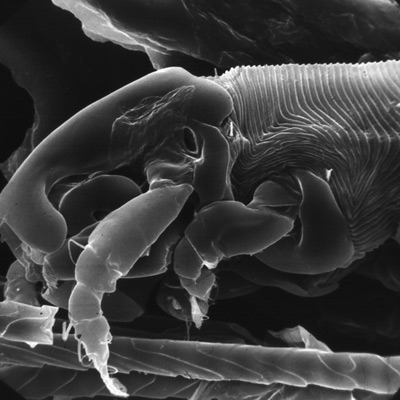NUMERICAL MODEL OF ANIMAL HAIRS
Computerized treatment requires transcription of morphological features into alphanumerical shape. In the code system used in the FURSKIN program, each structural
feature is represented by a letter of the alphabet. All micro-morphological variants of the feature are described by numbers. The first three letters represent skin
surface, shape of upper part of follicles and average number of hairs in a follicle. The following eleven letters represent structural features of three main hair
types, particularly fine fibers, intermediate fibers and guard hairs. Therefore, these letters are used three times.

| Surface of skin: | a - b - c |
| Fine fibers: | d - e - f - g -h - i - j - k - l - m - n |
| Intermediate fibers: | d - e - f - g -h - i - j - k - l - m - n |
| Guard hairs: | d - e - f - g -h - i - j - k - l - m - n |
Any individual letter in this scheme describes the following structural pattern:
a - appearance of skin surface (3 types)
b - the shape of upper part of follicles (6 types)
c - number of fibers in follicle (3 types)
d - the shape of hair cross-section (9 types)
e - shape of cuticular scales (16 types)
f - surface of cuticular scales (3 types)
g - the shape of scale margins (2 types)
h - size of medulla (4 types)
i - longitudinal shape of medulla (2 types)
j - shape of medullar cross-section (4 types)
k - structure of medulla (16 types)
l - structure of medullar filling (8 types)
m - minimal and maximal thickness of fiber shafts (in µm)
n - extent of hair lengths (in mm)
HOW THE IDENTIFICATION WORKS
The FURSKIN program understands the comparison of structural features of a tested sample with a huge volume of structural data offered by an ensemble of expressive fur skins. The micro-morphological patterns of tested fur skin are placed into a computer and compared by program procedures. For each fur skin species a calculated "score of similarity" is represented by a number of structural differences. All scores are arranged in descending order and results are displayed or printed.
THE EFFECTIVENESS OF THE FURSKIN PROGRAM
The effectiveness was tested by cross-comparison of 134 fur skin species to find the most similar couples. The results in the following table suggest the important diagnostic feature of hair microscopic structure. The minimal number of differences between couples was ten dissimilarities in micro-structural patterns.
| THE GREATEST SIMILARITY IN MICRO-MORPHOLOGY | NUMBER OF DIFFERENCES |
THE LEAST SIMILARITY OF MICRO-MORPHOLOGY | NUMBER OF DIFFERENCES |
|||
| Talpa micrura vs. Talpa europaea | 10 |
Capra sibirica vs. Arvicola terrestris | 29 |
|||
| Equus caballus vs. Equus caballus (Hucul variety) | 10 |
Desmana moschata vs. Kobus ellipsiprymnus | 29 |
|||
| Dama dama vs. Ovis musimon | 12 |
Putorius putorius vs. Cryptoprocta ferox | 29 |
|||
| Rangifer tarandus vs. Cervus elaphus wapiti | 13 |
Meles meles vs. Ovis aries - Persian lamb skin | 29 |
|||
| Panthera tigris altaica vs. Panthera pardus | 13 |
Castor fiber vs. Tamandua tetradactyla | 29 |
|||
| Antilope cervicapra vs. Kobus ellipsiprymnus | 13 |
Canis familiaris collie vs. Otocolobus manul | 29 |
|||
| Martes zibellina vs. Lutreola lutreola | 14 |
Oryctolagus cuniculus vs. Vulpes vulpes | 30 |
|||
| Tamandua tetradactyla vs. Boocercus euryceros | 15 |
Sus scrofa scrofa vs. Giraffa camelopardalis | 30 |
|||
| Cynocephalus temmincki vs. Lemur cata | 15 |
Alopex lagopus vs. Vulpes vulpes | 33 |
|||
| Hylobates lar vs. Ovis aries - Cigaja lamb skin | 16 |
Antidorcas marsupialis vs. Equus przewalskii | 34 |
|||
| Cercopithecus mona vs. Hylobates lar | 16 |
Choloepus didactylus vs. Connochaetes gnou | 37 |
|||
| Ovis aries - Cigaja lamb skin vs. Cercopithecus mona | 16 |
Dicotyles tajacu vs. Canis familiaris collie | 43 |
DISCUSSION
The comparative study with 134 different fur skin species validates the long accepted diagnostic ability of the microscopic method for identification of small samples.
Comparison among species discovered an average number of 20 important dissimilarities between most of the species. This demonstrates a high degree of individuality
of fur skin micro-morphology.
In spite of the range, including over 10,000 micro-photos, the study cannot be considered as fully thorough. More work needs to be done to determine the differences
over skin areas, winter and summer coats, between male and female animals, changes induced by maturation and on domesticated animals. It is also important to determine
the effect of variability among races. This study should be of a non sustainable range and may be too expensive if compared with its usefulness. On the contrary, owing
to this structural variability, different samples of identical species may not have a zero level of dissimilarity. The accessible number of differences eventually would
be in the range of dozens.
Copyright © 2011 Furskin Co.